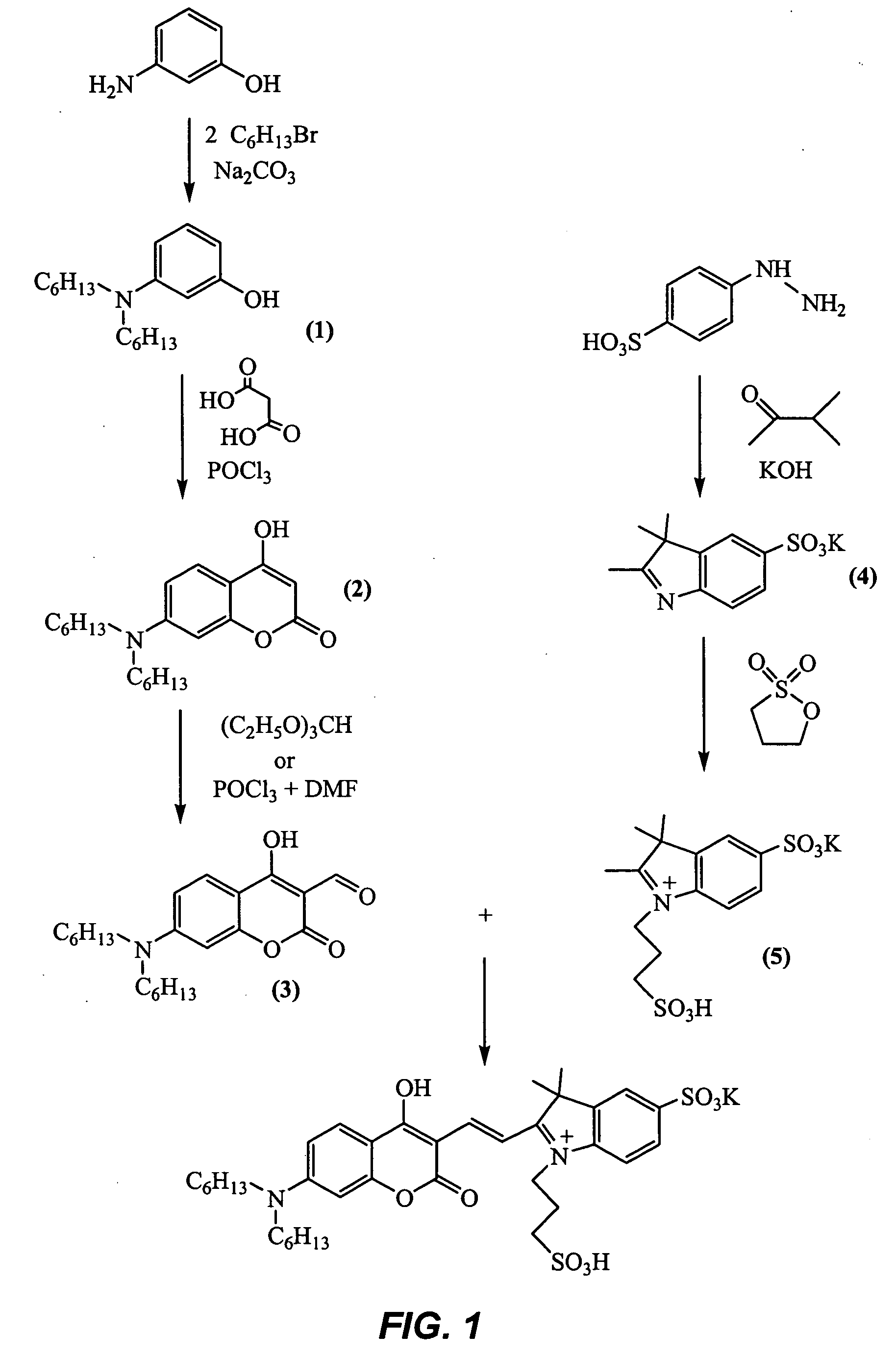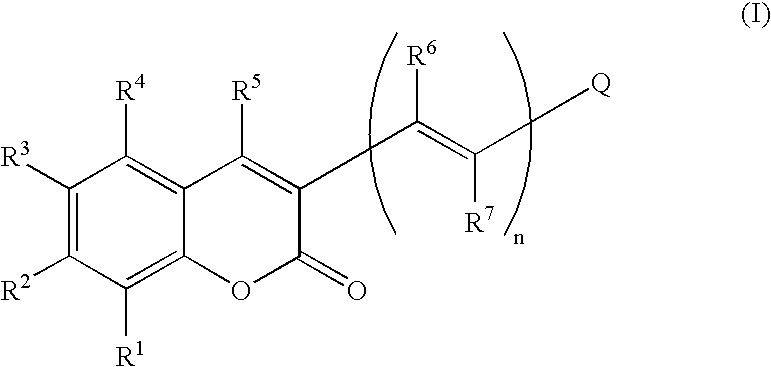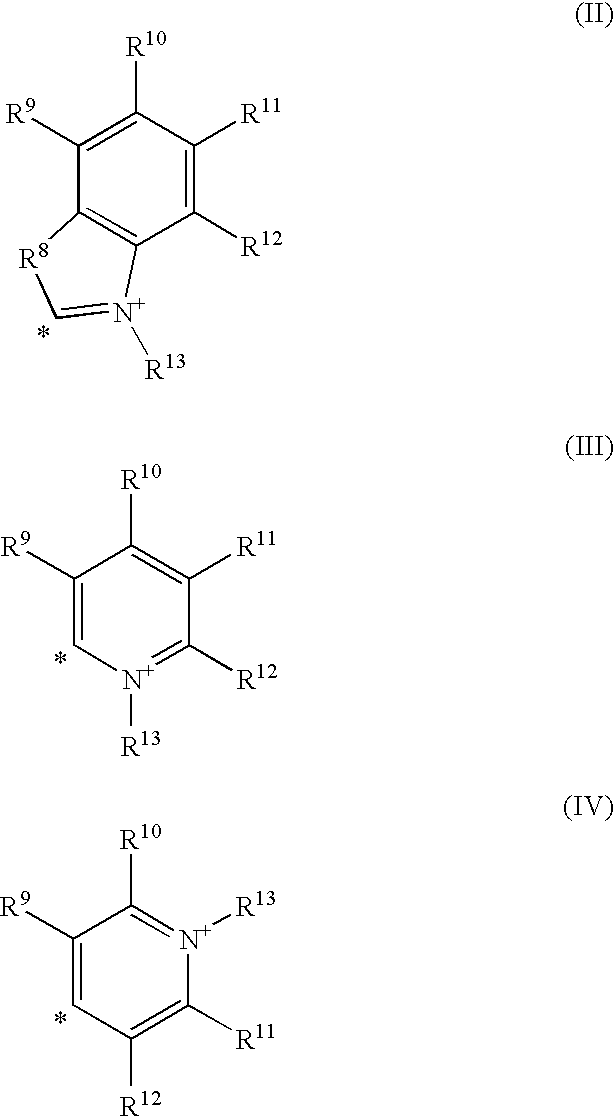Coumarin-based cyanine dyes for non-specific protein binding
a cyanine dye and non-specific technology, applied in the field of cyanine dyes for non-specific protein binding, can solve the problems of time-consuming, labor-intensive or incomplete procedures of this kind, and achieve the effect of measurable fluorescence and effective use in protein detection and quantification
- Summary
- Abstract
- Description
- Claims
- Application Information
AI Technical Summary
Benefits of technology
Problems solved by technology
Method used
Image
Examples
example 1
Effect of Protein on Fluorescence of Coumarin-Based Cyanine Dyes
[0023] A series of coumarin-based cyanine dyes within the scope of Formula I above were tested by the following procedure. A 20 mg / mL solution of denatured protein (yeast alcohol dehydrogenase or bovine carbonic anhydrase in 8 M urea) was diluted 100-fold into 50 mM sodium formate pH 4.0 to a final concentration of 0.2 mg / mL. Dye was added from a DMSO stock solution (0.4-1 mM) to a final concentration of 200 nM. The resulting mixture was incubated at room temperature for at least 15 minutes and fluorescence readings were taken on an Aminco Bowman Series 2 Luminescence spectrometer with the excitation and emission monochrometers set at the absorbance and emission maxima, respectively, for each dye. The spectrometer slit width was set at 4 nm. Fluorescence readings at the same wavelengths were also taken of each dye diluted identically into buffer without added protein.
[0024] The peak fluorescence intensities measured i...
example 2
Use of Coumarin-Based Cyanine Dye for Staining 1-D SDS-PAGE Gel
[0025] An 18-well 4-20% Tris-Ci gel (Criterion® System of Bio-Rad Laboratories, Inc., Hercules, Calif., U.S.A.) was loaded with serial dilutions of broad range SDS-PAGE standards (Bio-Rad Laboratories, Inc.) and subjected to electrophoresis according to the manufacturer's instructions. The dilutions and the lanes in the gel in which each dilution was d were as listed below:
Lane No.Load (ng of each protein)1(blank)296034804240512066073081598104112121130.5140.25150.125
[0026] The gel was fixed for 16.5 hours in 300 mL of 40% (volume / volume) ethanol and 10% (volume / volume) acetic acid. Following the fixing step, the gel was stsained in 125 mL of a solution consisting of 0.2 μM of Compound 8 of Example 1 in 30% (volume / volume) methanol and 1% (volume / volume) oxalic acid. After 2 hours and without washing of the gel after the application of Compound No. 8, the gel was scanned on an FX fluorescence scanner (Bio-Rad Laborator...
example 3
Use of Coumarin-Based Cyanine Dye for Staining 2-D Gel
[0027] Immobilized pH gradient strips (ReadyStrip® IPG strips, 11 cm pH 3-10 NL, Bio-Rad Laboratories, Inc.) were loaded with 40 μg of E. coli protein in 8 M urea, 2% CHAPS, 40 mM dithiothreitol, 0.2% (weight / volume) Bio-Lyte ampholyte pH 3-10 (Bio-Rad Laboratories, Inc.). First-dimension isoelectric focusing followed by equilibration and second-dimension of SDS-PAGE were performed as described in the ReadyStrip® instruction manual. Criterion® 8-16% Tris-Cl gels (Bio-Rad Laboratories, INc.) were used for the second dimension. The resulting 2-dimensional gels were fixed for 1 hour in 170 mL per gel of 40% (volume / volume) ethanol and 10% (volume / volume) acetic acid, and stained with 200 mL of a solution consisting of 0.2 μM of Compound 8 of Example 1 in 30% (volume / volume) methanol and 7% (volume / volume) acetic acid. After 2 hours and without washing of the gel after the application of Compound No. 8, the gel was scanned on an FX ...
PUM
 Login to View More
Login to View More Abstract
Description
Claims
Application Information
 Login to View More
Login to View More - R&D
- Intellectual Property
- Life Sciences
- Materials
- Tech Scout
- Unparalleled Data Quality
- Higher Quality Content
- 60% Fewer Hallucinations
Browse by: Latest US Patents, China's latest patents, Technical Efficacy Thesaurus, Application Domain, Technology Topic, Popular Technical Reports.
© 2025 PatSnap. All rights reserved.Legal|Privacy policy|Modern Slavery Act Transparency Statement|Sitemap|About US| Contact US: help@patsnap.com



